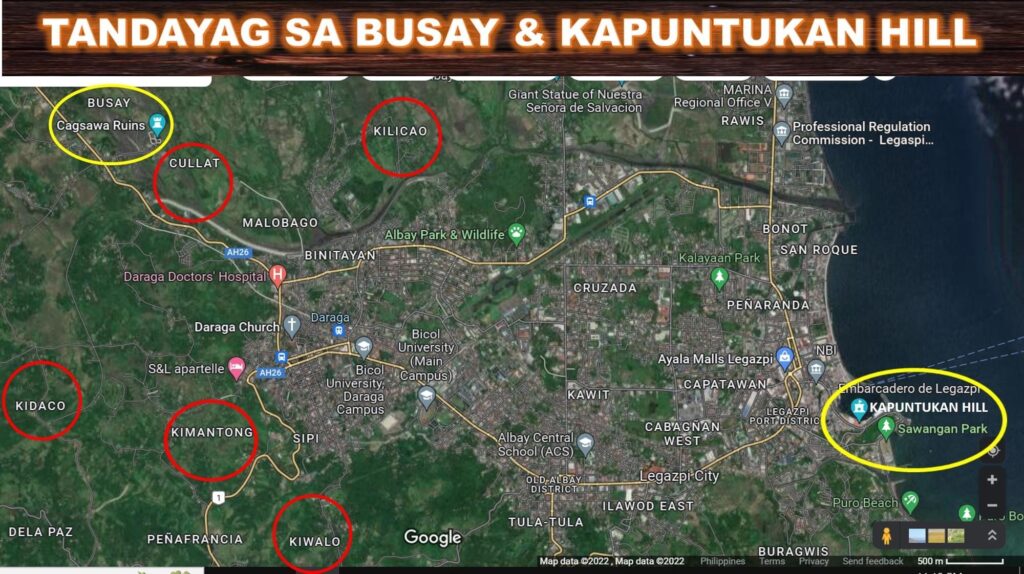By Abdon M. Balde Jr.
TANDAYAG SA BUSAY & THE LEGEND OF KAPUNTUKAN HILL
I was speculating on what adventure I might create for Baltog in order to establish his leadership traits and prove him worthy of becoming a real chieftain, I noticed the waterfalls called Busay near Cagsawa in a sitio now called Cullat (Cullat is in the Spanish orthography but locally pronounced “kulyat). Kulyat is the name of a sturdy native tree. Busay is the generic Bikol name for a waterfalls—so in fact Busay Falls is a redundancy. If Baltog and his men rowed upstream towards Camalig where Tondol was, they would discover that the river flowing out of Makabalo River in the old Sawangan (now Legazpi City) came from the waterfalls at Busay. The stream of that river winds on the edges of the old Cagsawa town, flows down the rear of Lingyon Hill and exits to the sea as Yawa River in Rawis.
Now here comes the importance of knowing the ancient names of places—names tied up to history and to the culture of the people living within the vicinity. I noticed places with old names such as Kimantong, Kidaco, Kiwalo and Kilicao. So I consulted Prof Merito Espinas and asked him about the names of these places. His reply: “Dong, kaitong panahon an mga lugar ipigngangaran sa pamayo o pinaka-prominenteng tawo sa lugar na iyan” (Dong, in olden times places are named after the head or the most prominent person in that place.). Then I asked what Kimantong means. His reply: “Dong, gustong sabihon kan mantong pamoso.” (Dong, Mantong means famous.) Thus, I found my story! Here is the story I created:
Baltog and his men rowed from the Makabalo River upstream until they reach shallow waters at a place called Kilikaw—and the head of that village welcomed them. Immediately, Baltog knew why the place had such name: the chief was so bow-legged that a pig might freely pass between his legs without him noticing it. The word “likaw” in Bikol means “detour”. In a show of hospitality, Likaw offered Baltog and his men food. After the mini feast, Likaw told Baltog of the problem that beset his village. He said that the river that came from Busay and was supposed to flow to their fields and irrigate their plantations were diverted by the nearby upstream villages. This, according to him, was the reason why the river at Kilikaw was shallow. The nearby villages were ruled by Mantong, Walo and Dako. Mantong of Kimantong was a very vain yet famous man. Walo of Kiwalo had his two fingers bitten off by a wild animal so he had only eight hand fingers. Dako of Kidako was known for being well endowed and a womanizer.
So Baltog and his men went up to Busay—which at that time was a mighty falls with the water cascading down the very tall cliff. But what bothered Baltog was that the great volume of water falling was not all flowing out as a river for the nearby villages. Baltog concluded that water must be escaping somewhere to another village or to the sea. Great volume of water was lost. Baltog sent divers to investigate. The divers found out that there was a Tandayag as huge as a mountain living under the waterfalls. A Tandayag was an ancient animal that over the years has grown enormous and hoary it could hardly move on land. Thus it crawled to the sea or any body of water where it was buoyant and could occasionally float.
Baltog called Likaw, Mantong, Dako and Walo to a meeting and plotted on how to kill the Tandayag under the waterfalls. Baltog advised them to use huge trunks of trees which pointed tips were spiked with the venom of serpents called rimoranon and designed catapults to launch the trunks as missiles. A wise old man advised them to aim at the eyes and the head—the venom will blind the Tandayag and disintegrate its head. On the appointed day, all the sturdy men of the four villages were united under the command of Baltog in slaying the monster under the water. When the head of the Tandayag started to disintegrate, it writhed and thrashed in pain and escaped through a secret cavern under the waterfalls. The thrashing of the huge monster generated a large tremor that caused the hill of the waterfalls to crumble to what it is nowadays—a small waterfalls. But because the cavern was closed, the water that flow was sufficient to irrigate all the farms of the four villages! The villages had their sufficient supply of water. Thus Baltog was hailed by all as a true hero and became the chieftain of the entire area!
What happened to the Tandayag? Many people at Sawangan say that the huge monster from Busay surfaced—without a head—near its shore at noontime the day after it was slain by Baltog and his men. Thus it was called Kapuntukan because it appeared when the sun was on top of their heads. It floated there for a long, long time, got petrified and fossilized and became the Kapuntukan Hill near the Port of Legazpi. This became the mountain used as a pillow by the giant Kulakog.


